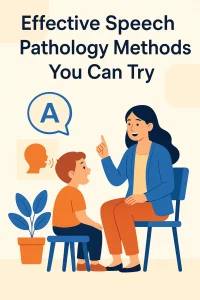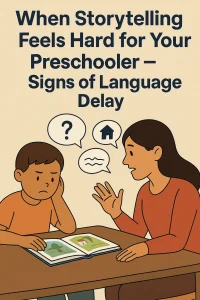Differences Between Articulation and Speech Disorders
By Wellness Hub
Last Updated: December 16, 2024
Understanding the differences between articulation and speech disorders is essential for effective communication support. These conditions can greatly affect someone’s ability to express themselves, impacting daily life. This guide aims to clarify these terms, aiding early detection and intervention. Here at Wellness Hub, we provide expert resources and tools tailored to support diverse speech therapy needs, empowering individuals to improve their communication skills efficiently and confidently.
What Are Speech Disorders?
Speech disorders cover various issues that impact the ability to form words clearly. These include problems like stuttering, where speech is interrupted by repetitions, and dysarthria, which happens when speech muscles are weak, making words sound unclear. Another common type is apraxia of speech, where someone struggles to move their mouth the right way to speak. Understanding these disorders helps in treating them effectively, improving how individuals communicate in daily life.
Read More: Speech Sound Disorders: Causes, Treatment and Strategies
What Are Articulation Disorders?
Articulation disorders occur when someone can’t make certain sounds correctly. This might mean swapping sounds, skipping them, or adding extra ones, which makes their speech hard to understand. Treatment typically involves speech therapy, where therapists teach correct sound production, strengthen speech muscles, and enhance clarity.
Read More: Articulation Disorder in Children: Signs, Causes & Treatment
Common Articulation Errors and Identification Tips
| Articulation Error | Example | Description | Identification Tip |
|---|---|---|---|
| Substituting ‘w’ for ‘r’ | “wabbit” for “rabbit” | Incorrect tongue positioning leads to wrong sounds. | Listen for ‘w’ sounds where ‘r’ should be in words. |
| Skipping ‘s’ sounds | “nake” for “snake” | Omission of ‘s’ at the beginning of words. | Note missing sounds in usual ‘s’ starting words. |
| Adding extra sounds | “balack” for “black” | Unnecessary sounds inserted into words. | Check for extra syllables or sounds in simple words. |
Key Differences Between Articulation and Speech Disorders
| Aspect | Articulation Disorders | Speech Disorders |
|---|---|---|
| Definition | Problems with forming specific sounds correctly. | Broad category that includes issues with fluency, voice pitch, volume, and clarity of speech. |
| Focus | Mechanical and physical – about the movement of the mouth to produce sounds. – Saying “wabbit” instead of “rabbit” (sound substitution). – Omitting sounds, like “bo” instead of “boat.” – Distorting sounds, like a lisp. | Encompasses the quality, flow, and clarity of speech, sometimes extending beyond articulation. – Stuttering (fluency issue). – Speaking too softly or too loudly (volume issue). – Hoarse or strained voice (voice pitch issue). |
| Causes | Physical or mechanical challenges, like difficulty with tongue or lip movement. | Neurological issues, muscle weakness, or developmental delays affecting speech flow and quality. |
| Impact | Clarity of specific sounds or words. | Overall speech clarity, fluency, and vocal quality. |
| Therapy | Targeted at improving sound production through physical and mechanical exercises. | Can involve multiple approaches, including fluency training, voice therapy, and articulation work. |
Comparing Symptoms:
- Articulation Issues: Incorrect sound production; clear voice but incorrect pronunciation.
- Speech Disorders: May include incorrect sound production, but also issues with fluency (like stuttering), voice quality (such as hoarseness), and the rhythm of speech.
Common Causes of Speech and Articulation Disorders
Speech and articulation disorders can arise from a variety of causes, impacting both children and adults. These disorders can stem from physical abnormalities, neurological conditions, or developmental delays. Understanding these causes is crucial for effective intervention and support, which can significantly improve communication abilities.
- Physical Causes: Issues such as cleft palate, dental problems, or insufficient muscle tone can affect how speech sounds are produced. Physical abnormalities can hinder the movement needed for clear speech.
- Neurological Causes: Disorders like cerebral palsy, traumatic brain injury, or stroke can impair the brain’s ability to control speech muscles. This can lead to difficulties with articulation and other aspects of speech.
- Developmental Causes: Sometimes, speech and articulation disorders are part of broader developmental delays. Conditions like autism spectrum disorders or hearing impairments can affect how children learn to speak and understand language.
- Genetic Factors: In some cases, speech disorders may run in families, suggesting a genetic component to these conditions.
- Environmental Factors: Lack of exposure to language, poor acoustic environments, and limited verbal interaction can also contribute to the development of speech and articulation disorders.
At Wellness Hub, we recognize these challenges and offer tailored resources that cater to the diverse needs arising from these various causes. Our tools and strategies are designed to support effective communication development, regardless of the underlying cause.
Know more about this Stuttering: Disorder or Disability? What You Need to Know
Impact on Daily Life
Speech and articulation disorders can significantly impact daily life, affecting everything from basic communication to social interactions and educational or career opportunities. The inability to communicate clearly can lead to frustrations, social isolation, and reduced self-esteem.
- In Children: Speech disorders can affect academic performance and social interactions. Children may struggle with reading, writing, and participating in classroom activities, which are crucial for educational success.
- In Adults: These disorders can limit job opportunities and affect professional relationships. Adults may find it challenging to express their ideas clearly or to engage in social situations comfortably.
- Emotional Impact: Often overlooked is the emotional toll these disorders can take. Individuals with speech and articulation disorders might experience anxiety, depression, or withdrawal from social situations.
Role of Speech Therapists
Speech therapists play a pivotal role in diagnosing, treating, and supporting individuals with speech and articulation disorders. Their expertise is crucial in helping people of all ages improve their communication abilities, leading to better personal, academic, and professional outcomes.
- Assessment and Diagnosis: The first step a speech therapist takes is to assess the individual’s speech and communication skills. This involves detailed observations, standardized tests, and discussions with family members or teachers to determine the nature and extent of the disorder.
- Developing a Treatment Plan: Based on the assessment, speech therapists design a personalized treatment plan that addresses specific needs. This plan might include exercises to improve diction, the pace of speech, volume control, and the rhythm of speech. For articulation disorders, therapists focus on techniques that enhance the clarity and accuracy of sounds.
- Implementing Therapy: Speech therapy sessions can be one-on-one or in small groups and may take place in various settings, including clinics, schools, or via teletherapy. Therapists use a range of engaging activities to make the process enjoyable and effective, such as storytelling, singing, and interactive games, which help reinforce the learning objectives.
- Monitoring Progress: Therapists regularly monitor the individual’s progress and adjust treatment plans as necessary. This ongoing evaluation ensures that the therapy remains effective and meets the changing needs of the individual.
- Educating and Supporting Families: A crucial part of a speech therapist’s role is to educate and involve family members in the treatment process. By teaching families how to support therapy goals at home, therapists extend the benefits of professional intervention into the individual’s everyday environment.
- Advocacy and Awareness: Speech therapists also advocate for individuals with communication disorders, raising awareness about these conditions and the importance of early intervention. This advocacy helps reduce stigma and promotes a broader understanding of speech and articulation disorders.
Conclusion
Understanding and treating speech and articulation disorders can greatly improve one’s quality of life. These conditions impact daily communications, affecting confidence and opportunities. At Wellness Hub, we provide personalized, innovative solutions for better speech. Our programs involve families, ensuring everyone plays a part in improving communication. If you or a loved one needs help, don’t hesitate to contact us. Let us guide you toward clearer speech and a more fulfilling life with our expert support. Visit our blog for more insights and tips on managing speech disorders effectively.
Frequently Asked Questions:
1. What causes speech disorders in children?
Speech disorders in children can arise from a variety of causes including genetic factors, neurological conditions, and physical issues like hearing loss or oral abnormalities. Sometimes, environmental factors such as limited exposure to language or poor speech models also contribute to these disorders.
2. How can I tell if my child has an articulation disorder?
Signs of an articulation disorder include difficulty making certain sounds, substituting one sound for another, adding extra sounds, or leaving sounds out. If your child’s speech is hard to understand compared to children of the same age, it might be time to consult a speech therapist.
3. What is the difference between a speech disorder and an articulation disorder?
A speech disorder refers to any difficulty with producing speech sounds, fluency, voice, or rhythm that disrupts communication. An articulation disorder is specifically the difficulty in making certain sounds correctly, affecting how clearly one can speak.
4. At what age should I seek help if I suspect my child has a speech disorder?
Early intervention is key in speech therapy. If you notice any signs of a speech disorder by the age of 2 or 3, it’s a good idea to consult a speech therapist. The earlier the intervention, the better the outcomes for speech development.
5. How do speech therapists diagnose speech disorders?
Speech therapists use a variety of assessments, including listening to the child speak, using standardized tests to compare the child’s abilities to developmental norms, and physical examinations to look for any structural problems. This comprehensive evaluation helps to diagnose the specific type of speech disorder.
6. Can speech disorders be cured?
While not all speech disorders can be ‘cured,’ many can be effectively managed or improved through speech therapy. The success of treatment can depend on several factors including the disorder’s cause, severity, and the age at which therapy begins.
7. What are some effective home exercises for speech therapy?
Parents can engage their child in simple activities like reading aloud together, practicing the sounds or words the child struggles with, playing games that involve speaking and listening, and singing songs to improve rhythm and fluency.
8.How often should my child see a speech therapist?
The frequency of therapy sessions can vary based on the child’s needs. Generally, a speech therapist may recommend sessions one to two times per week, but this can adjust depending on progress and goals.
9. What role do parents play in speech therapy?
Parents play a crucial role in their child’s speech therapy by reinforcing practices and exercises at home. Consistent support and practice can significantly enhance the effectiveness of professional therapy, and therapists often provide guidance and resources for home use.
10. Where can I find resources for helping my child with a speech disorder?
Parents can access a variety of resources at Wellness Hub’s resource page, which offers tools, activities, and informational guides to support your child’s speech development. This includes exercises, apps, and advice articles to help parents assist their children effectively.
About the Author:
Rajini Darugupally
M.Sc., Speech-Language Pathologist (9+ years of experience)
Rajini is a passionate and dedicated Speech-Language Pathologist with over 9+ years of experience, specializing in both developmental speech and language disorders in children and rehabilitation in adults. Currently, at Wellness Hub, she thrives in a team environment that values innovation, compassion, and achieving results for their clients.
Book your Free Consultation Today
Parent/Caregiver Info:
Client’s Details:
* Error Message









